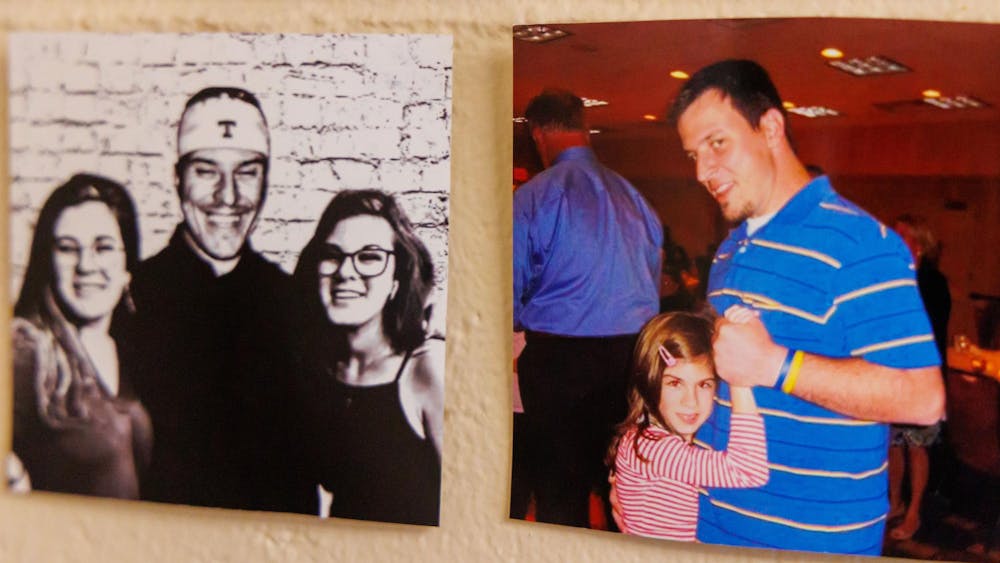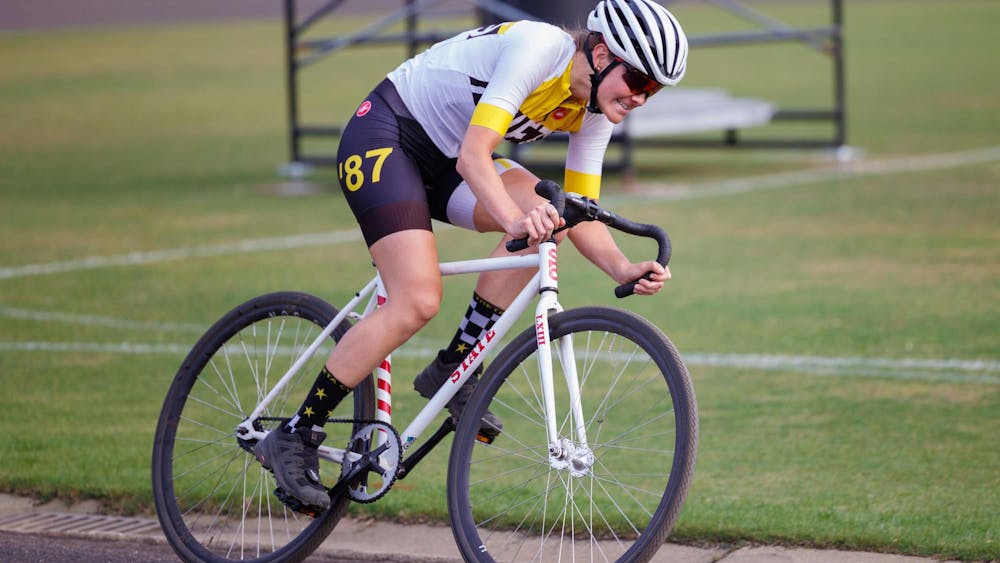Seventeen college students stand in a weight room of the School of Health, Physical Education and Recreation, looking on as a powerlifter demonstrates the proper way to do a squat. Instructor Greg Simmons points out the lifter's taut, perfect form and thighs' alignment with the ground, then tells the lifter to release the bar.\n"Any questions for Michelle?" Simmons asks.\nMichelle Amsden, a graduate student studying kinesiology, is the nation's No. 1 powerlifter in the 123-pound weight class. She is visiting Simmons' intermediate weight training class to do demonstrations for his students.\nAmsden isn't the only one breaking gender barriers -- five of the 17 members of the class are women.\nMore and more IU students are slowly enrolling in classes and declaring majors dominated by members of the opposite sex, faculty say. \nWhile the proportions of undergraduate men and women in computer science and elementary education have remained stagnant since 1993, the proportions in biology, business, journalism and psychology have shifted roughly 6 to 15 percentage points over the last decade.\nMore substantial increases were seen in biology and marketing. For example, 49.5 percent of biology majors were women in the fall of 1993, but 56.1 percent of the majors are currently women, a 13.3 percent change. Among marketing majors, the percentage of women increased from 38.2 percent in the fall of 1993 to 52.6 percent this spring, a 37.7 percent change.\nIn general, women dominate in the humanities and social sciences, and are underrepresented in sciences and math, according to the Office for Women's Affairs.\nOut of the current 25 most popular majors among undergraduates, men most significantly outnumber women in finance, business, management, informatics, computer information systems and social studies. Women, on the other hand, outnumber men in elementary education, journalism, psychology, exercise science, fine arts and apparel merchandising. \nIn a class or major where one gender dominates, students said they are both educating and being educated on topics and perspectives previously discussed only in limited capacities. \nLifting stereotypes\nAt 5-foot-1 with a blond pixie haircut and perfect makeup, Amsden looks like a weightlifting Tinkerbell -- a Tinkerbell that can bench press 225 pounds and squat 380.\nAmsden said myths about the female body cause some women to be more hesitant about weightlifting than men.\n"I think women underestimate themselves when they start out," Amsden said. "They start lower than they're capable because of misconceptions about getting big."\nIn Simmons' five years as a weightlifting instructor at IU and as a personal fitness trainer, he said he has noticed more women getting involved in the previously male-dominated world of weightlifting -- 17 of his 30 clients during the last few years have been women.\nWhile most women in the HPER weight room are sticking to an aerobic workout on the ellipticals, roommates and seniors Allison Allie and Eileen Coleman spot each other during their bench pressing and bicep curls in the weight training class. They said they took the class because they wanted to learn about weightlifting. \n"It's hard to do on my own because I'm unfamiliar with the maneuvers and everyone else is busy doing their own thing," Coleman said.\nAllie said being in a class primarily composed of men didn't intimidate her. She would rather be exercising instead of sitting in one of her business classes.\nJunior Eduardo Abud-Sturbaum said he was just as comfortable having women in the class as they were to be there. \n"I'm fine with it," he said. "I don't feel pressured or intimidated -- I just do my own thing."\nOutside-the-box step Freshman Nay Naing links a hand with his dance partner's. He observes his feet shuffling below him in an effort to match the beat of Madonna's "Cherish."\n"I've never danced before," Naing said. "I've never understood the concept of dancing."\nOut of the 105 students in senior Sara Dalton's two ballroom and social dance classes, 23 are men. In this particular session, there are seven men and 48 women.\n"There seems to be a hesitancy on guys' part to sign up because (ballroom dance) seems 'girly,'" Dalton said.\nAlthough male enrollment has increased over the past few years, Dalton said most of the men have no background in ballroom dance. What men might lack in coordination they usually make up for in effort, she said. And they tend to have no problem asking questions.\nSophomore Douglas Munsey said he enrolled in ballroom dancing because it was something different -- a practical skill he will need when he's older and out in the business world. He said the female-to-male ratio was just an extra incentive -- he only has to learn the "guy's part" of the dance.\nWhile some men might have ulterior motives for joining female-dominated classes, sophomore Ueline Newmon said he didn't think a guy would involve himself with something he didn't want to do.\n"I don't see a guy doing (an activity) for two hours if he didn't really want to be there," said Newman, who has attended hip-hop dance sessions at the Student Recreational Sports Center. "He might stop in the door and watch, but he wouldn't participate."\nMind over subject matter\nEnrollment differences are not reserved to HPER courses; they can also be seen in the academic spectrum.\nJournalism professor Radhika Parameswaran said about 20 percent of students in her last few Race, Gender and the Media classes have been men interested in learning about diversity.\n"Women seem to take the class because they want to understand why they do what they do," Parameswaran said. "It's a personal journey for them."\nThe title "gender" implies a biased topic about women, she said, so more women gravitate toward the class. If the stereotype was eliminated, men would probably be more inclined to take gender classes. Three of the current 34 undergraduate gender studies majors are men.\n"Most men are more comfortable exploring racial issues, not because they understand women but because they feel race is a more interesting and important issue," Parameswaran said.\nShe hasn't noticed any animosity between men and women in the class and, if anything, women enjoy learning a different perspective on situations.\n"I don't think men have hesitated to speak up," Parameswaran said. "Women seem to support them -- not pick on them."\nPhysics professor Catherine Olmer said in order for students to become more comfortable taking classes in which they are outnumbered by the opposite gender, support needs to come from faculty and other students.\n"There's no single remedy for (gender disparity in enrollment); it's a much more complex problem," Olmer said. "A lot of things have to change on many levels."\nOlmer noted any discrimination experienced by women in male-dominated majors -- or vice versa -- is not as overt as it used to be. If faculty members discourage students based on gender, it's now on a more subconscious level coming out of the faculty members' own experiences with members of their gender and their expectations of their colleagues.\nContinuous and subtle discouragement can make people feel they don't belong in a class, Olmer added.\n"Students need to be more stubborn," Olmer said. "If someone likes a particular topic, why can't they do it? If men like gender studies, grab it. It's hard enough to find something you would like to do for the rest of your life, so do it"
Male, female students are Breaking barriers
Get stories like this in your inbox
Subscribe





